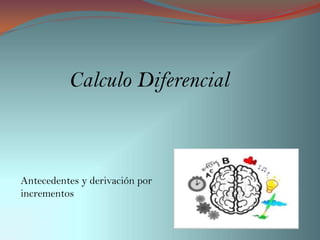Calculo diferencial
•
0 recomendaciones•319 vistas
El documento trata sobre los antecedentes y la derivación por incrementos en el cálculo diferencial. Explica que el cálculo diferencial surgió en el siglo XVII al estudiar la velocidad de los cuerpos en movimiento y que su principal objeto de estudio es la derivada. Además, define la derivada por incrementos como el límite del cociente del incremento de la variable dependiente entre el incremento de la variable independiente cuando este tiende a cero.
Denunciar
Compartir
Denunciar
Compartir

Recomendados
Recomendados
Más contenido relacionado
Destacado
Destacado (20)
Product Design Trends in 2024 | Teenage Engineerings

Product Design Trends in 2024 | Teenage Engineerings
How Race, Age and Gender Shape Attitudes Towards Mental Health

How Race, Age and Gender Shape Attitudes Towards Mental Health
AI Trends in Creative Operations 2024 by Artwork Flow.pdf

AI Trends in Creative Operations 2024 by Artwork Flow.pdf
Content Methodology: A Best Practices Report (Webinar)

Content Methodology: A Best Practices Report (Webinar)
How to Prepare For a Successful Job Search for 2024

How to Prepare For a Successful Job Search for 2024
Social Media Marketing Trends 2024 // The Global Indie Insights

Social Media Marketing Trends 2024 // The Global Indie Insights
Trends In Paid Search: Navigating The Digital Landscape In 2024

Trends In Paid Search: Navigating The Digital Landscape In 2024
5 Public speaking tips from TED - Visualized summary

5 Public speaking tips from TED - Visualized summary
Google's Just Not That Into You: Understanding Core Updates & Search Intent

Google's Just Not That Into You: Understanding Core Updates & Search Intent
The six step guide to practical project management

The six step guide to practical project management
Beginners Guide to TikTok for Search - Rachel Pearson - We are Tilt __ Bright...

Beginners Guide to TikTok for Search - Rachel Pearson - We are Tilt __ Bright...
Calculo diferencial
- 1. Calculo Diferencial Antecedentes y derivación por incrementos
- 2. Antecedentes El cálculo diferencial se origina en el siglo XVII al realizar estudios sobre el movimiento, es decir, al estudiar la velocidad de los cuerpos al caer al vacío ya que cambia de un momento a otro. El principal objeto de estudio en el cálculo diferencial es la derivada.
- 3. La derivada se ha convertido en herramienta fundamental, puesto que permite tanto determinar cómo predecir el comportamiento de las diversas variables involucradas en un fenómeno. Los conceptos de velocidad y la aceleración son aplicaciones de la derivada como razón de cambio.
- 4. Precursores ISAAC NEWTON GOTTFRIED LEIBNIZ PIERRE FERMAT
- 5. DERIVADA POR INCREMENTOS Consiste en el estudio del cambio de las variables Formula dependientes cuando cambian las variables independientes de las funciones o campos objetos del análisis.
- 6. Ejemplo Un ejemplo numérico. Sea
- 7. Esto significa que la derivada es el límite del cociente del incremento de la variable dependiente, entre el incremento de la variable independiente, cuando éste tiende a cero, y se denota por:
- 8. Por definición, los incrementos pueden ser: ∆ > 0 si el valor final es mayor que el inicial ∆ < 0 si el valor final es menor que el inicial ∆ = 0 si el valor final es igual que el inicial
- 9. Bibliografía Escobar Jairo (): Antecedentes del cálculo diferencial [en línea] http://jairoescobarcun.blogspot.mx/2010/11/calculo- diferencial-historia-y.html Antecedentes del cálculo diferencial [en línea] http://es.scribd.com/doc/54655092/Antecedentes- Historicos-de-Calculo-Diferencial Derivación por incrementos [en línea] http://www.fic.umich.mx/~lcastro/3%20derivada.pdf Dr. Becerra Espinosa José Manuel () Facultad de Contaduría y Administración. UNAM. Derivada [en línea] http://www.fca.unam.mx/docs/apuntes_matematicas/27. %20Derivada.pdf